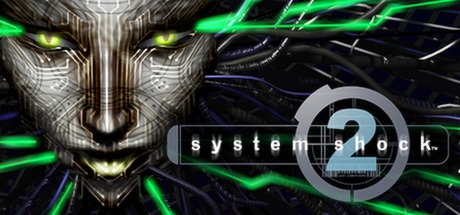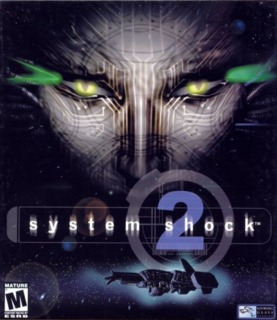
Looking back on cultural artefacts from past decades one must always remember that people back then genuinely believed that mini-disc players were the future. Perms, double-denim, Showaddywaddy; we can’t blame the past for these abominations, but what we can do is learn from their mistakes and vow never to make them again. Since this review will be all about looking to the past, let’s skip briefly four minutes into the future: System Shock 2 was a great game in 1999 and it is still a great game in 2015; it’s problems are mostly indicative of the era in which it was made, and so the caveat ‘made in the 90s’ is one that should be mentally appended to almost everything I have to say about System Shock 2.
Set in a late-90s imagining of a near future in which everything has been designed with a ruler, you play as a nameless, voiceless polygon awoken from cryo-sleep aboard the Von Braun, a faster-than-light spaceship which has been overrun by mutants. As you bludgeon your way through the ship, you pick up audio logs and slowly learn what happened to turn everyone into monstrosities.
The observant among you will note a hint of sarcasm regarding the visual aspects of System Shock 2, so let’s address the issue right from the top: to our spoilt 2015 minds with our sophisticated physics and rendering systems, games from the 90s look primitive at best, but there is a certain irony in the modern obsession with increasing levels of graphical quality when you consider that the true pinnacle of video game achievement seems to be the moment where you see past the visuals and forget that you are playing a game. I understand the importance of visuals in drawing a player into the world but developers need to understanding that there is a law of diminishing returns when it comes to the graphical quality of their games: the more you spend achieving near photo-realistic quality in your graphics the more players will stop noticing them.
With this in mind, commenting on System Shock 2’s graphics seems to be doing it a disservice, but they are worth commenting upon precisely because they didn’t interfere with my investment in the world. Shamefully, I am the sort of person for whom the graphical qualities of a game are quite important and I went into System Shock 2 expecting to be alienated by the murky textures and wooden animations but the gameplay is so rewarding that after a while you don’t notice the utter inability of the software to render curved lines and find yourself fully immersed within the game.
Heightened immersion in the world of System Shock 2 is enabled by tightly structured gameplay which is not without the quirks that are to be expected with a game from 1999. Hacking is unfathomable, the map is obtusely small, and the game does a frankly appalling job of identifying what exactly you should be doing at any given moment; the idiot arrow was but a twinkle in the eye of an EA executive in 1999, but System Shock 2 goes in the opposite direction, hiding your objectives ten mouse clicks away in a sub-menus. I have no shame in admitting that I consulted a walkthrough at one point, because while the game was asking me to go to Point A, what I actually had to do to was kill an enemy at Point B first. The inventory system is somewhat fiddly as well and gameplay doesn’t pause when you open it up, so switching and reloading weapons when you are being pursued by monstrosities becomes vexing to say the least. This does make sense in the logic of the world, however, as enemies slavering for your juicy organs do not wait patiently for you to finish selecting what type of ammunition you are going to be shortly applying to their frontal cortex.
System Shock 2, for all that we’ve said about having to criticise the game on it’s own terms, is not without problems that are relevant regardless of the era you are playing in; enemies spawn in areas that have already been cleared, and while I understand that the developers did this in order to provide constant challenge for the player, it doesn’t make sense in the context of an abandoned spaceship in the middle of space, and makes back-tracking (which you will do a lot of, by the way) frustrating and tedious, two emotions that you do not want to experience while playing something that is ultimately there for your entertainment.
While we are speaking of emotions, if we can learn something about the era by playing a game, then by playing System Shock 2 we can deduce that in the late 90s developers hated gamers almost as much as gamers hated themselves. This game is hard. Ammunition is scarce to the point that you need to make every shot count, weapons will break if you use them too often, and when that moment comes you better hope you’ve upgraded your repair skill enough or you’ll be facing down a pair of Cyborg Midwives (perhaps the most sinister enemy I’ve come across in a game) with nothing more than a solid wrench and your hopes and dreams. And don’t go thinking you can change the difficulty level to get past a particularly tricky section, you coward, because if you do you’ll have to restart the game. From the beginning.
As a result, if I have one tip for playing System Shock 2, it would be save early, and save often. You may as well map quick save and quick load to the ‘q’ and ‘e’ keys or you’ll spend more time looking at the in-game menu rather than actually playing, which leads me to the controls. You’ll want to re-map those as well, because by default ‘a’ and ‘d’ are ‘look left’ and ‘look right’, and, weirder, ‘s’ is ‘crouch’. ‘Invisi-lean’ is present as well, and you have to manually change over different types of ammunition for the same weapon in the inventory screen, so, purely in terms of controls, System Shock 2 is very much a game of its time.
If I may adopt the vocabulary of a pretentious tosspot for a moment, System Shock 2 is very much a genre piece, and should be played accordingly to enjoy it as it was intended. This is not an action FPS, and if you choose to play it as such by storming into rooms guns blazing you will quickly find that a) your childhood memories being devoured by deranged hybrids and b) you have no idea why they are being devoured in the first place. System Shock 2 favours the more considered, thoughtful approach, and players who are prepared to take their time to listen to all the audio logs and explore the world of the Von Braun will be rewarded with an intriguing story. If you aren’t interested in narrative and exploration then you’ve come to the wrong place I’m afraid as the game cannot offer you very much in the way of rewarding gunplay – if you want that, and you are somehow reading this from the past, play Half-Life.
System Shock 2 is an interesting artefact in the history of videogames because you can see so much of it in the games we play today, both in terms of narrative and gameplay. The use of audio logs as a storytelling technique was continued in the Bioshock games and is present in modern shooters such as The New Order, for instance. It isn’t just a dusty curio though – for all of its flaws it is still a coherent gameplay experience that deserves a look for fans of the latter day Bioshock games or RPG fans in general.

